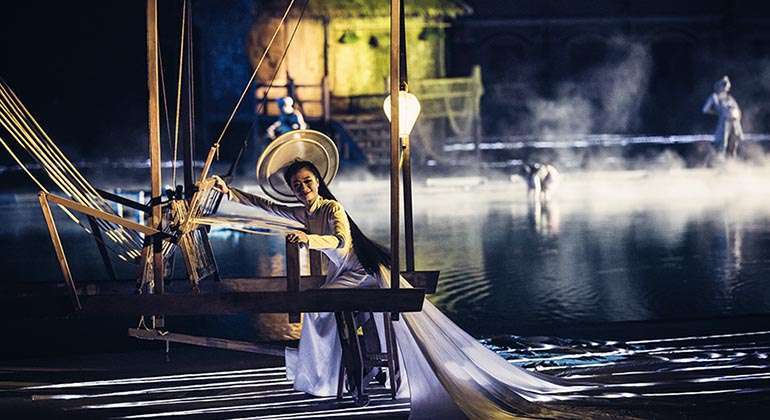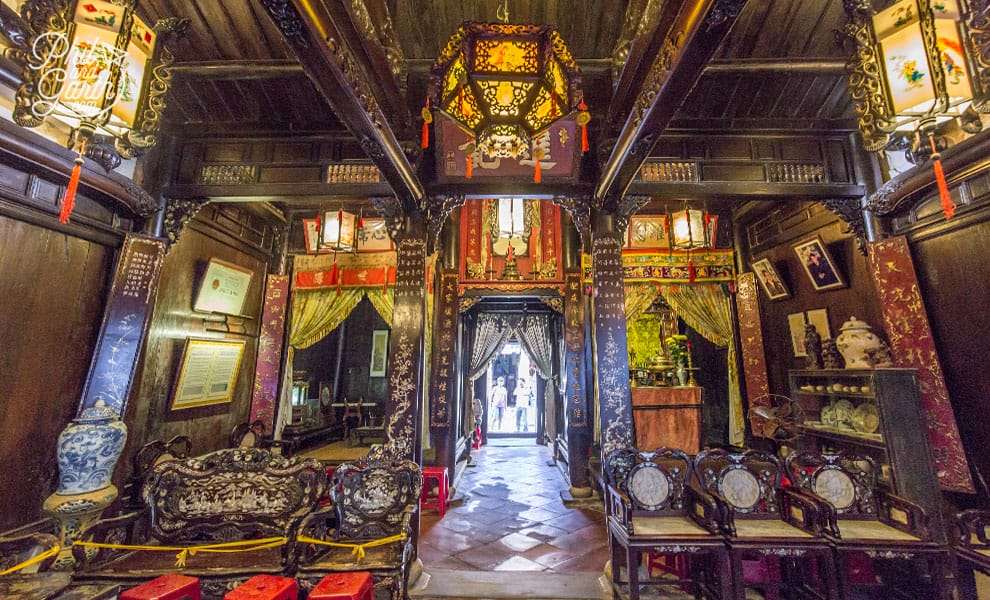Vietnam’s coastal town of Hoi An is a treasure trove of history and culture, offering a journey through time with its well-preserved architecture, rich cultural heritage, and scenic beauty. This guide will take you through seven remarkable historical sites in Hoi An, providing detailed information on how to visit each one and make the most of your trip. Here’s everything you need to know about these enchanting historical sites in Hoi An.

I – Historical Site in Hoi An ancient town:
1 – Fukian Assembly Hall
Historical site in Hoi An: Start your journey in the heart of Hoi An with a visit to the Fukian Assembly Hall. This beautiful hall stands as a testament to the vibrant cultural exchange between Vietnam and China. Built in the late 17th century by Chinese merchants, it is a key historical site in Hoi An. The hall is dedicated to Thien Hau, the goddess of the sea, worshipped by the Chinese community. Its intricate carvings and colorful decorations reflect the rich heritage and architectural brilliance of the Chinese settlers in Hoi An.
Getting There:
- Taxi Service: For a hassle-free ride, book a taxi through Hoi An Fairy Tour.
- Motorbike Rental: For those who prefer more flexibility, consider renting a motorbike. Check out options on the Hoi An Fairy Tour website.
2. Historical Site in Hoi An Ancient town: Old House of Phung Hung
Next on our list of historical sites in Hoi An is the Old House of Phung Hung. This beautifully preserved 18th-century merchant house offers a glimpse into the opulent lifestyle of Hoi An’s prosperous traders. The house showcases a unique blend of Vietnamese, Chinese, and Japanese architectural influences, making it a significant historical site in Hoi An.
Highlights:
- Architecture: Note the intricate woodwork and the traditional furniture that adorns the house.
- Cultural Insights: Learn about the history of the house and the family that lived here.
Getting There:
- Bicycle: Explore the town by renting a bicycle from Hoi An Fairy Tour.
- Walking: It’s a short walk from the Fukian Assembly Hall, allowing you to enjoy the quaint streets of Hoi An.
3. Historical Site in Hoi An Ancient town: Old House of Tan Ky
Another must-visit historical site in Hoi An is the Old House of Tan Ky. This 200-year-old house is a perfect example of a typical Hoi An merchant’s residence. It features a blend of Vietnamese, Chinese, and Japanese architectural styles, and the interior is filled with antiques and traditional furniture.
Highlights:
- Historical Significance: Understand the role of Hoi An in international trade through the artifacts displayed.
- Architectural Beauty: Admire the unique combination of various architectural styles.
Getting There:
- Walking: Located in the ancient town, it’s easy to reach on foot from other nearby historical sites in Hoi An.
4. Historical Site in Hoi An Ancient town: Museum of Trade Ceramics
Unravel the maritime history of Hoi An through a fascinating collection of ceramics at the Museum of Trade Ceramics. This museum, housed in a restored timber-framed building, reflects Hoi An’s bustling trading port status during the 16th and 17th centuries.
Highlights:
- Ceramics Collection: Explore artifacts that date back to the ancient trade routes.
- Cultural Exchange: Learn about the influence of different cultures through the ceramics.
Getting There:
- Bicycle: Rent a bicycle from Hoi An Fairy Tour for a leisurely ride to the museum.
- Walking: It’s located within the ancient town, making it accessible by foot.
5. Historical Site in Hoi An Ancient town: Chua Cau (Japanese Bridge)
Chua Cau, or the Japanese Bridge, is an iconic symbol of Hoi An and a key historical site. Built in the early 17th century by the Japanese community in Hoi An, this bridge harmoniously blends Japanese and Vietnamese architectural styles.
Highlights:
- Architectural Wonder: Notice the ornate carvings and the bridge’s unique roof.
- Historical Significance: Understand the cultural exchanges between different communities in Hoi An.
Getting There:
- Walking: The bridge is centrally located and easily accessible from other historical sites in Hoi An.
II – Historical Site that is near Hoi An city: My Son Sanctuary

My Son Sanctuary: A Window into Ancient Champa Civilization
Nestled in the lush forests of Central Vietnam, near the village of Duy Phú, My Son Sanctuary is a compelling historical site that offers a glimpse into the rich cultural tapestry of the ancient Champa civilization. This group of abandoned and partially ruined Hindu temples was consecrated to the worship of the god Shiva, known here as Bhadreshvara.
The origins of My Son can be traced back to the 4th century when the first temple was built by King Bhadravarman. The sanctuary flourished as a religious and cultural capital of the Champa Kingdom. It was continuously developed over the next ten centuries, with more than 70 structures dedicated to Hindu deities being constructed by successive Champa rulers. The architecture of My Son represents a unique adaptation of Indian Hindu temple architecture with indigenous influences, characterized by its red brick constructions and sandstone bas-reliefs depicting Hindu mythology.
A major highlight of My Son is its impressive tower temples. These structures, built without the use of mortar and designed to withstand the harsh tropical climate of Central Vietnam, showcase the ingenuity and mastery of ancient Cham architects. The temples’ intricate carvings and sculptures stand as a testament to the artistic prowess of the Cham people.
Throughout its history, My Son was not only a religious site but also a cultural and intellectual hub where scholars, priests, and artisans gathered. Despite suffering significant damage during the Vietnam War and from natural erosion, My Son remains a significant historical and cultural site, reflecting the spiritual and artistic heritage of the Champa civilization.
In 1999, My Son was recognized as a UNESCO World Heritage site, underscoring its importance and ensuring its preservation for future generations. Today, visitors to My Son can explore the sanctuary’s ruins and experience the serene atmosphere of a site that has stood the test of time, offering insight into a civilization that flourished for centuries in Vietnam’s storied past.
Highlights:
- Temple Ruins: Explore the intricate carvings and the historical significance of these ancient temples.
- Cultural Heritage: Learn about the Champa Kingdom and its influence on Vietnamese culture.
Getting There:
- Scooter: Rent a scooter for an hour-long scenic ride to My Son Sanctuary from Hoi An. Book through Hoi An Fairy Tour.
- Private Taxi: For a comfortable journey, hire a private taxi through Hoi An Fairy Tour.
- Tour Packages: Opt for a guided tour package that includes transportation, guided visits, lunch, and more. Check out Hoi An Fairy Tour for options.
Tips for Visiting Historical Sites in Hoi An
When planning a visit to the enchanting historical sites of Hoi An, there are a few practical tips to enhance your experience and ensure respect for the cultural heritage. Here’s a brief guide to help you navigate these treasures:
- Dress Appropriately: While a formal dress code is not required when visiting Hoi An’s historical sites, it is important to dress modestly to respect the cultural norms. Avoid wearing overly revealing or sensitive outfits. Comfortable, light clothing that covers shoulders and knees is recommended, especially when entering religious sites.
- Purchase an Entrance Ticket: Access to historical sites in Hoi An requires an entrance ticket, which you can purchase at various ticket counters located throughout the Old Town. These tickets are typically bundled with several coupons; each coupon allows you entrance to one site. It’s a convenient system that lets you explore multiple locations with a single purchase.
- Engage with On-Site Information: Upon arriving at each historical site, look out for employees who provide brief introductions or historical insights about the place. These talks are invaluable for understanding the rich history and significance of the site. Engaging with these explanations will greatly enhance your visit and provide deeper context to what you are seeing.
By following these simple guidelines, your visit to Hoi An’s historical sites will be both enjoyable and respectful, allowing you to fully immerse yourself in the town’s rich cultural tapestry.
Discover the Rich History of Hoi An Through Guided Tours and Cultural Shows
To truly appreciate the depth of Hoi An’s historical and cultural heritage, engaging in guided tours and attending local shows can offer insightful and memorable experiences. Here are some of the best ways to delve into the history of Hoi An:
1. Hoi An Memories Show: A spectacular outdoor performance, the Hoi An Memories Show is a must-see cultural extravaganza that brings the rich history of Hoi An to life. Held at the impressive Hoi An Impression Theme Park, this largest-scale outdoor visual arts performance in Vietnam features a cast of nearly 500 actors and actresses. The show takes you on a 400-year journey through Hoi An’s history, showcasing traditional music, dance, and drama alongside modern audio-visual effects on a colossal stage with the open sky as its backdrop. This immersive performance is not just entertainment; it’s an education in the cultural fabric and historical changes that have shaped Hoi An.

2 – My Son Tour from Hoi An: My Son Tour takes you to the ancient Cham ruins, a spiritual center of the Champa Kingdom. Located in a lush valley near Hoi An, these Hindu temples were built between the 4th and 14th centuries. Guides provide insightful information on Cham civilization, architecture, and the site’s significance. It’s an enriching experience for history enthusiasts.

3. Hoi An Walking Tour: To experience the essence of Hoi An’s rich past, nothing compares to a walking tour through its historic Old Town. These guided tours offer a close look at the architecture and layout, which reflect the diverse influences of the various traders from around the world who settled in Hoi An centuries ago. As you wander through narrow lanes lined with ancient buildings, vibrant markets, and bustling cafes, guides share stories of the Japanese Covered Bridge, the ornate Chinese assembly halls, old canals, and wooden merchant houses. Each site is steeped in history, offering insights into the trading culture that once made Hoi An a Southeast Asian trading hub.
Participating in these tours and shows provides a deeper understanding and appreciation of Hoi An’s historical significance and cultural richness. Whether you are mesmerized by the vibrant spectacle of the Hoi An Memories Show, intrigued by the ancient ruins of My Son, or charmed by the atmospheric streets of Hoi An’s Old Town, these experiences are sure to enrich your visit with unforgettable insights into the spirit and history of this enchanting town.
Conclusion
Visiting these historical sites in Hoi An offers an enriching experience blending natural wonders with cultural heritage. Whether you opt for a leisurely stroll through the ancient town, an adventurous scooter ride to My Son Sanctuary, or a guided tour, you’re sure to create lasting memories. Plan your trip with Hoi An Fairy Tour for a seamless and enjoyable adventure exploring the captivating historical sites in Hoi An.
From Vincent – the Author
If you find this post useful and would like to show your appreciation, you can support me by making a donation via PayPal. Your generosity helps me continue creating helpful content. Thank you!
Paypal Link: [Click here]
HOI AN FAIRY TOUR – HOME – TAXI – TOUR/SHOW – BIKE/BUS/BOAT – LOCAL RECOMMENED

